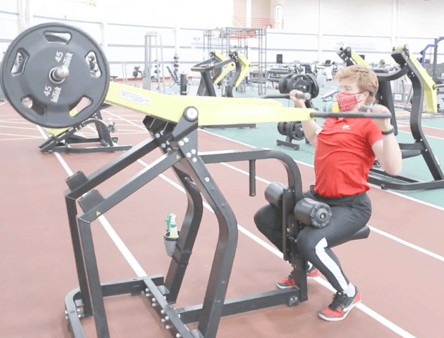 The traditional bodybuilding split of working one muscle group per day might work for the dedicated, high-level competitive bodybuilder who makes their living in the gym. But for the general population only looking to shed some unwanted pounds and improve their overall health, the traditional bodybuilding split is not ideal. Working multiple muscle groups in the same session is much more ideal because it ramps up the body’s metabolism more than working a single muscle group each day. To achieve this, we train the movement, not the muscles.
The traditional bodybuilding split of working one muscle group per day might work for the dedicated, high-level competitive bodybuilder who makes their living in the gym. But for the general population only looking to shed some unwanted pounds and improve their overall health, the traditional bodybuilding split is not ideal. Working multiple muscle groups in the same session is much more ideal because it ramps up the body’s metabolism more than working a single muscle group each day. To achieve this, we train the movement, not the muscles.
The Four Movement Patterns
There are four main categories in which we categorize the movement patterns: push, pull, squat, and hinge. Each category works a movement while working multiple muscle groups.
Push
This upper-body movement pattern uses all of your “pushing” muscles. The pushing muscles of the upper body include the chest, shoulders, and triceps. Common movements within this category include the following:
- Barbell Bench Press (Chest)
- Dumbbell Bench Press (Chest)
- Incline Bench Press (Chest)
- Overhead Press (Shoulder)
- Arnold Press (Shoulder)
- Skull Crusher (Triceps)
- Triceps Extension (Triceps)
Read my full blog on the Push movement.
Pull
This upper-body movement pattern uses the “pulling” muscles. The pulling muscles of the upper body include the lats and the biceps. There are two different pulling variations, the horizontal pull and the vertical pull. The horizontal pull targets the lower lats and the vertical pull targets the upper portion of the lats. It is important to include both variations in your program. Common movements within this category include the following:
- Pull-ups (Vertical)
- Lateral Pull-Down(Vertical)
- Barbell Rows (Horizontal)
- Dumbbell Rows (Horizontal)
- Seated Cable Row (Horizontal)
- Curl variations (Biceps)
Read my full blog on the Pull movement.
Squat
The squat movement pattern is the pushing movements pattern for the lower body. The squat pattern mainly works the quadriceps and the glutes. This category also includes all single-leg movements. The squat pattern is a large compound movement that should be progressed properly. Common movements in this category include the following:
- Squat to a Chair
- KB or DBL Goblet Squat
- Double KB Squat
- Barbell Front Squat
- Barbell Back Squat
- Lunges (Single Leg)
- Split Squat (Single Leg)
Hinge
The hinge movement pattern is the pulling movement pattern for the lower body. The hinge pattern is better known as the deadlift. The primary muscles worked during the hinge movement are the hips, hamstrings, and lower back. The deadlift is another exercise that should be progressed properly for safe lifting. On days that you work the hinge pattern, you should do some additional hamstring isolation movements. Common movements for the hinge pattern include the following:
- Kettlebell Deadlift (Hinge)
- Hex Bar Deadlift (Hinge)
- Barbell Deadlift (Hinge)
- Barbell or Dumbbell Romanian Deadlift (Hinge)
- Hamstring Curls (Hamstring Iso)
Using the Movement Patterns
Knowing that there are four movement patterns, and which movement pattern works which muscle group, you can build your exercise routines. In a future blog, I will discuss why the full-body program is superior, and how to schedule your week using the movement patterns. In short, you can build your exercise routine by putting together two or more of the movement patterns in one day. After working a muscle group, you don’t want to work that same muscle group for at least 48 hours.
***
If you need any help building an exercise program, or want a health professional or personal trainer to put one together for you, come visit us at the Track Desk at any time.
This blog was written by Evan James, NIFS Exercise Physiologist EP-C, Health Fitness Instructor, and Personal Trainer. To learn more about the NIFS bloggers, click here.

